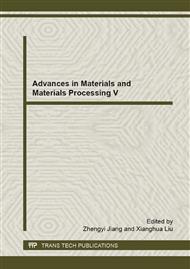p.107
p.111
p.115
p.119
p.124
p.130
p.135
p.140
p.145
Galvanic Corrosion of 70-30 Copper-Nickel Alloy in Contact with Nickel-Aluminum Bronze in Simulated Deep Sea Environment
Abstract:
The galvanic corrosion behavior of 70-30 copper-nickel alloy as a brand new seawater pipe material and nickel-aluminum bronze as the commonly used pipe valve material in simulated low temperature conditions of deep sea was studied. The galvanic corrosion potential and galvanic current density of the pair were monitored, and the galvanic corrosion tendency and effect at different temperature were evaluated. Combined with the electrochemical measurements, the influence of seawater temperature on galvanic corrosion behavior was also discussed. The results showed that as the result of coupling, 70-30 copper-nickel alloy acting as the coupled cathode was prevented from corrosion, while nickel-aluminum bronze became the sacrificial anode. With the decrease of seawater temperature, the galvanic corrosion tendency and galvanic corrosion rate of the pair decreased. The change in galvanic corrosion tendency with seawater temperature was attributed to the different electrochemical properties induced by the inherent difference in chemical compositions of the alloys. The low galvanic corrosion rate and effect were related to the reduced mass transfer rates at low temperature. Moreover, the electrochemical behavior of the copper alloys was much sensitive to the change in the amount of dissolved oxygen at the lower seawater temperature, especially for the alloy with higher passivation ability, i.e., 70-30 copper-nickel alloy.
Info:
Periodical:
Pages:
124-129
Citation:
Online since:
March 2015
Authors:
Price:
Сopyright:
© 2015 Trans Tech Publications Ltd. All Rights Reserved
Share:
Citation:


